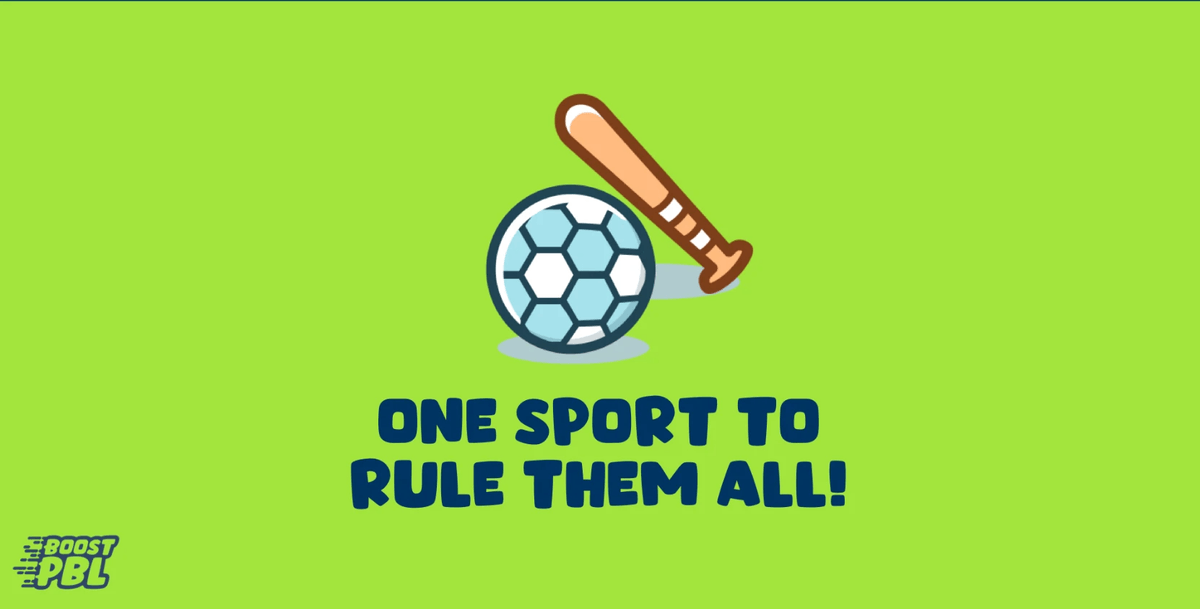
- Standards
- …
- Standards
- Standards
- …
- Standards
Invent a New Sport
3rd-5th or 6th-8th Full Project, Mini-Project, and Sprint

PBL Experience Overview
1. Project Summary
- Grade Levels: 3rd to 8th Grades
- Theme: Creativity, Engineering, Inclusivity, and Collaboration
- Objective: Students design an original sport using provided materials and a systematic process. They develop rules, create models, and analyze how the sport incorporates inclusivity and engagement for diverse participants.
- Duration:
- Full Project: 3 weeks, 30-45 minutes per day
- Mini-Project: 5-7 days, 30-45 minutes per day
- Sprint: 2-3 days, 45-60 minutes per day
2. Standards Alignment
NGSS Standards
- MS-ETS1-1: Define the criteria and constraints of a design problem with sufficient precision to ensure a successful solution, considering scientific principles and impacts on people and the environment.
- Application: Students identify the requirements for their sport, focusing on inclusivity, safety, and engagement.
- MS-ETS1-2: Evaluate competing design solutions using a systematic process to determine how well they meet the criteria and constraints.
- Application: Students compare ideas within their teams to choose the most effective sport features.
- MS-ETS1-3: Analyze data from tests of prototypes to identify optimal characteristics for success.
- Application: Students test their sport and refine rules or materials to improve gameplay.
- MS-ETS1-4: Develop a model for iterative testing and modification of a proposed object, tool, or process.
- Application: Students create models of their sport and revise them based on peer feedback.
Common Core ELA Standards
- Writing:
- W.6.2–W.8.2: Write informative and explanatory texts to examine and convey ideas clearly.
- W.6.4–W.8.4: Produce writing that is clear, organized, and appropriate for the task and audience.
- Reading:
- RI.6.1–RI.8.9: Analyze informational texts, including data and visuals, to inform decisions.
- Speaking & Listening:
- SL.6.1–SL.8.6: Engage in collaborative discussions, present findings, and adapt speech to the context.
Common Core Math Standards
- Statistics and Probability:
- 6.SP.5–8.SP.4: Collect, summarize, and interpret data related to surveys and gameplay analysis.
3. Thematic Connections
- Science Concepts:
- Physics: Explore forces and motion as they relate to gameplay mechanics.
- Material Science: Investigate which materials provide durability and flexibility for sports equipment.
- Math Integration:
- Geometry: Use 3D shapes to design playing fields, equipment, and scoring systems.
- Data Analysis: Use survey results and testing feedback to refine rules and gameplay.
- Social Studies Integration:
- Explore cultural influences on sports and the role of inclusivity in community activities.
- Research historical sports development to inspire new ideas.
- ELA Integration:
- Writing comprehensive rules for the sport and creating persuasive advertisements to attract players.
4. Benefits of Project-Based Learning
Grades 3-5
- Creative Exploration: Encourages students to think outside the box while addressing real-world constraints.
- Team Collaboration: Builds teamwork as students design, test, and refine their sports.
- Problem-Solving: Develops early engineering and critical thinking skills.
Grades 6-8
- Systematic Thinking: Introduces complex design processes, including iterative refinement and data analysis.
- Empathy Development: Promotes inclusivity by encouraging students to design sports accessible to all participants.
- Leadership and Communication: Builds confidence as students present and justify their designs.
5. Additional Benefits
- Engagement: Hands-on design and gameplay energize students and encourage active participation.
- Cross-Disciplinary Learning: Combines STEM, ELA, and social studies for a comprehensive learning experience.
- Innovation and Creativity: Inspires students to think inventively and apply knowledge to real-world contexts.
6. Implementation Examples
- Week 1:
- Introduce the project and explore existing sports for inspiration.
- Discuss the importance of inclusivity and begin brainstorming ideas for the sport.
- Create a list of key features the sport should include.
- Week 2:
- Design teams draft rules, build models using provided materials, and create scoring systems.
- Test prototypes and gather data through peer feedback.
- Revise designs to optimize inclusivity and engagement.
- Week 3:
- Finalize the sport, write clear instructions, and develop persuasive advertisements.
- Present the sport to classmates or an external audience, such as community members or parents.
- Reflect on learning outcomes and the design process.
7. Why This Project is Perfect for Grades 3-8
- Grades 3-5: Provides foundational engineering and design skills through accessible challenges and collaboration.
- Grades 6-8: Encourages critical evaluation of systems, incorporation of data analysis, and refinement of ideas, while fostering leadership.
The "Invent a New Sport" project empowers students to blend creativity with engineering and collaboration, offering an engaging and standards-aligned learning experience.
Home
Pricing Plans
Get Started
Contact Us
team@
© BOOST PBL 2024

